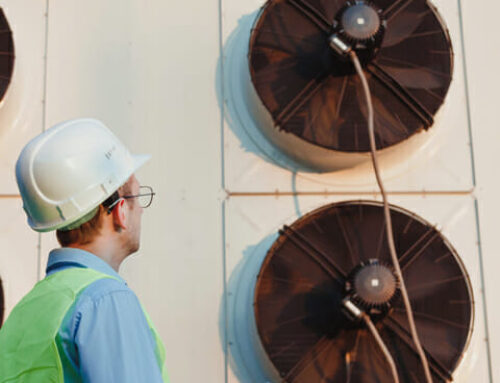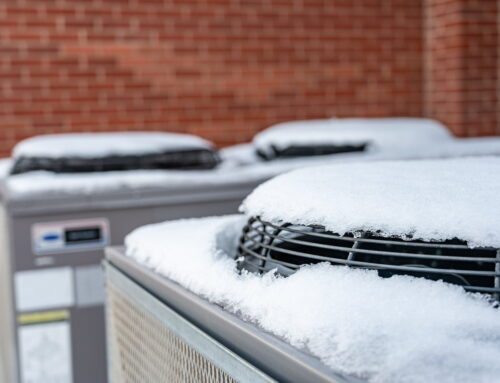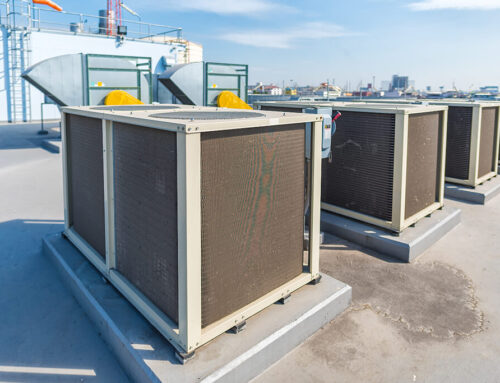In the bustling world of commercial real estate, traditional heating, ventilation, and air conditioning (HVAC) systems, known for their high energy usage and costs, are quickly becoming relics of the past as energy efficiency becomes crucial to maintaining an optimal indoor environment. Enter the era of innovative commercial HVAC designs, where energy efficiency, air conditioner technologies, and improved air circulation are not just buzzwords but foundational principles for a better indoor environment. These cutting-edge systems, including innovative technologies like air conditioners, promise to slash energy bills for cost savings and reduce carbon footprints without compromising on comfort or cooling performance. As we dive into the specifics, you’ll discover how modern technology, including efficient HVAC systems and energy efficiency measures, is transforming mundane buildings into smart, sustainable havens that are as kind to your wallet as they are to the planet by improving the indoor environment and reducing energy usage.
Understanding Energy-Efficient HVAC for Commercial Buildings
Cost Reduction
Energy-efficient HVAC systems, including heating, cooling, and air circulation, play a crucial role in minimizing operational costs and maximizing savings. They use less energy to heat or cool buildings. This results in lower electricity bills.
For instance, an innovative commercial HVAC design might include advanced sensors for heating, cooling, energy efficiency, and cost savings. Efficient commercial HVAC systems can adjust the heating temperature based on occupancy and weather conditions, enhancing energy efficiency. Businesses save money over time with such systems.
Sustainability Goals
Achieving sustainability through energy efficiency and efficient HVAC systems is a major goal for many businesses today, aiming for cost savings. Energy-efficient HVAC designs are key to this effort. They significantly reduce energy usage.
By using less energy, these commercial HVAC systems help cut down on carbon emissions and HVAC costs, leading to cost savings for businesses. This supports global efforts against climate change. Many businesses now prioritize green building certifications partly due to their HVAC choices, focusing on cost savings and SEER ratings.
Occupant Comfort
The comfort, productivity, and cost savings for building occupants are greatly influenced by HVAC efficiency and SEER ratings. Properly designed systems ensure consistent temperatures throughout the building. Efficient commercial HVAC systems also improve air quality, which can boost worker productivity and satisfaction, leading to cost savings. Moreover, addressing specific cooling needs with efficient HVAC systems makes spaces more comfortable for everyone, while also offering cost savings for commercial HVAC systems.
Efficient Design Strategies for Commercial HVAC Systems
High-Performance Materials
Opting for high-performance materials in commercial HVAC systems ensures optimal performance and cost savings. These materials, designed for commercial HVAC systems, are engineered to withstand extreme conditions while maintaining efficiency and savings. They lead to less wear and tear on commercial HVAC systems, prolonging the system’s life.
By choosing commercial HVAC components that offer superior durability and efficiency, businesses can significantly reduce maintenance costs. This approach not only supports sustainability but also enhances overall commercial HVAC system performance.
Renewable Energy Integration
Incorporating renewable energy sources like solar power into commercial HVAC designs is a game-changer. It reduces reliance on traditional energy sources, cutting down operational costs for commercial HVAC systems.
Solar panels can power certain parts of the HVAC system during peak sunlight hours. This integration helps in achieving significant energy savings over time in commercial HVAC systems. Plus, it positions businesses as leaders in environmental stewardship.
Advanced Insulation Techniques
Implementing advanced insulation techniques minimizes energy loss dramatically. Proper insulation ensures that heated or cooled air stays inside the building, requiring less effort from the HVAC system to maintain desired temperatures.
This strategy involves careful calculations and planning to identify areas in commercial HVAC systems most prone to energy loss. By addressing these weak points with high-quality insulation materials, commercial HVAC systems in buildings become more energy-efficient.
Innovations Transforming Commercial HVAC Technology
Smart Thermostats
Smart thermostats are a big leap in HVAC technology. They let buildings adjust temperatures automatically. This means less energy waste and more comfort.
These devices learn from your habits. Over time, they set the perfect temperature without you having to do anything. Many also allow remote control via smartphones.
Geothermal Solutions
Geothermal heating and cooling is another innovation changing the game. It uses the earth’s stable temperature to heat or cool buildings. This method is incredibly efficient.
It involves installing loops underground that exchange heat with the ground. In winter, they pull warmth into the building. In summer, they do the opposite by taking excess heat away.
IoT Integration
The introduction of IoT-enabled HVAC systems marks a significant advancement in tech for commercial buildings. These systems provide real-time data on how equipment operates. This allows for immediate adjustments to improve efficiency and reduce costs.
-
Pros:
-
Lower energy bills
-
Improved system lifespan
-
Enhanced comfort levels
-
Cons:
-
Higher initial setup cost
-
Requires technical expertise for installation and maintenance
Sustainable Comfort through Innovative HVAC Designs
Natural Ventilation
Natural ventilation plays a crucial role in innovative HVAC designs. It reduces the need for mechanical cooling and heating systems. Buildings can achieve this by incorporating large windows, operable skylights, and strategic building orientation.
This approach allows fresh air to circulate throughout the indoor spaces. It enhances comfort and maintains healthy humidity levels. Moreover, it leverages daylighting, minimizing artificial lighting usage during daytime hours.
Thermal Storage
Phase change materials (PCMs) are key features in advanced HVAC design. They absorb or release heat as they change states, like from solid to liquid. This property makes them ideal for maintaining comfortable indoor temperatures with less energy.
By integrating PCMs into building structures such as walls or floors, buildings store excess heat during the day and release it at night. This significantly reduces the load on heating and cooling systems, leading to improved energy efficiency.
Green Roofs
Green roofs are not just attractive; they’re functional components of eco-friendly HVAC systems. They provide additional insulation, reducing heating and cooling demands.
These roofs also improve air quality around facilities by filtering pollutants and carbon dioxide out of the air. The vegetation helps manage rainwater runoff too.
-
Pros:
-
Enhanced insulation
-
Better air quality
-
Rainwater management
-
Cons:
-
Higher initial installation cost
-
Requires maintenance
Innovative commercial HVAC designs prioritize sustainability while ensuring comfort in indoor environments. Techniques like natural ventilation utilize environmental conditions for better air circulation without heavy reliance on mechanical systems—making buildings more energy-efficient yet comfortable living spaces.
Zoning Controls and Automation Integration in HVAC Systems
Customizable Zones
Customizable temperature zones enhance comfort. They allow different areas of a building to have unique temperatures. This is key for buildings with varying occupancy or use throughout the day.
Owners can adjust temperatures based on time, use, or occupancy. For example, unoccupied rooms can be set to save energy while occupied ones stay comfortable. This leads to significant savings over time.
Automated Diagnostics
Automated fault detection spots problems early. It uses smart sensors and data analysis for timely maintenance. This keeps systems running efficiently and reduces unexpected repair costs.
Integration with building management systems centralizes control. Owners see everything from one place, making it easier to manage air distribution and circulation.
Centralized Control
Centralized control through integration simplifies managing an HVAC system. Building owners gain a clear view of how units across different areas are performing.
This setup uses virtual reality for training or troubleshooting without being onsite. It’s a game-changer for maintaining optimal performance and energy efficiency.
Financial Benefits of Energy-Efficient Commercial HVAC
Lower Bills
Investing in innovative commercial HVAC designs pays off. Firstly, energy efficiency means less power use. This directly cuts down utility bills.
Businesses see significant cost savings over time. For example, a well-designed system could slash energy costs by up to 30%. That’s money back in your pocket every month.
Property Value
Next, let’s talk about how these systems boost property value. Modern, efficient installations are attractive to potential buyers and tenants alike.
They signal that the building is up-to-date and cheaper to operate. This can increase the property’s market value significantly. It’s an investment that makes your building stand out.
Tax Incentives
Lastly, there’s more good news for businesses going green with their HVAC systems. Many governments offer tax incentives or rebates for energy-efficient investments.
These programs aim to encourage businesses to reduce their carbon footprint. They often cover a portion of the initial installation costs. So, not only do you save on operational costs but also get help with the upfront investment.
Maintenance Strategies for Long-Term Performance of Commercial HVAC Systems
Regular Cleaning
Regular maintenance is crucial. One key practice is cleaning and replacing filters regularly. This step ensures air quality stays high.
Dirty filters block airflow and strain the system. Clean filters mean better air and lower energy bills. It’s a simple yet effective way to keep systems running smoothly.
Scheduled Inspections
Another important strategy is scheduled inspections. These help find and fix problems early.
Inspectors look for leaks, wear, or damage in the system during these checks. Catching issues early prevents big repairs later on. It keeps the system efficient, saving money over time.
Predictive Maintenance
Lastly, adopting predictive maintenance can revolutionize how we maintain HVAC systems. Predictive maintenance uses data analytics to foresee potential failures before they happen.
This approach relies on sensors and smart technology to monitor system performance in real-time.
Choosing a Contractor for Commercial HVAC Needs
Experience Matters
Selecting the right contractor is crucial. Look for experience in energy-efficient systems. This ensures they understand innovative commercial HVAC designs.
Contractors with a solid track record know how to implement solutions that save energy and money. Ask about past projects similar to yours. This will give you confidence in their ability to deliver.
Check Credentials
It’s important to verify certifications and references. Certifications show the contractor’s commitment to quality and knowledge in commercial HVAC systems.
References provide insight into their work ethic and customer service. Contact previous clients to hear firsthand about their experiences. This step cannot be skipped if you want peace of mind.
Support Services
Consider ongoing support and maintenance services offered by the contractor. Regular maintenance is key for keeping your system running efficiently, as mentioned before.
A good contractor offers comprehensive service plans that cover regular check-ups and emergency repairs. These services are vital for businesses relying on uninterrupted operation of their commercial spaces.
Final Remarks
Diving deep into the world of energy-efficient commercial HVAC systems, we’ve explored everything from the nuts and bolts of efficient design strategies to the latest innovations shaking up the industry. These advancements aren’t just about keeping spaces comfortable; they’re a game-changer for slashing energy bills and reducing carbon footprints. By integrating zoning controls, automation, and sustainable designs, businesses are setting themselves up for long-term success, both financially and environmentally.
Now’s your chance to take action. Whether you’re upgrading an existing setup or starting from scratch, choosing the right contractor is crucial. Look for someone who gets the big picture—someone who’s not just selling you a system but a future-proof solution. Remember, investing in a state-of-the-art HVAC system is investing in the future of your business. So, let’s make it count. Ready to breathe new life into your building? Let’s chat about your next steps.






